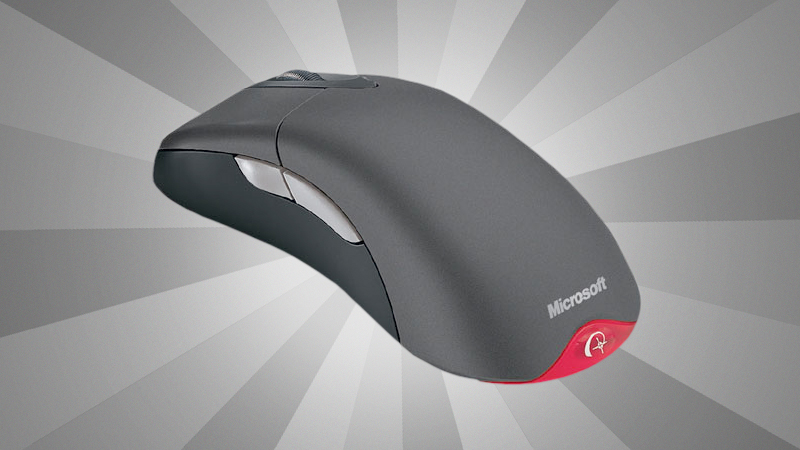20 years ago, Microsoft forever changed the way we use the mouse
- Transfer

Twenty years ago, in April 1999, Microsoft updated its IntelliMouse line of peripheral input devices. At first glance, there were not so many differences - the new mouse had several buttons and a scroll wheel - but in fact the company introduced the masses to technology that ended the prehistoric era of cleaning mice from dirt.
At that moment, I was in my third year at college, and in connection with my training in digital technologies, I spent many hours at Photoshop 5.5, which was bought at a very convenient student discount. My studies were not dependent on textbooks, as a result of which I had money for expensive photo editing software and a powerful desktop computer for those times (although by today's standards it is ridiculous - 16 MB of memory!). But the budget tablet Wacom didn’t fit into my budget, which was mainly bought by professionals who could afford such a luxury. And I had to use a mouse, whose work at that time relied on an archaic metal ball in a rubber shell that transmitted hand movements to the cursor on the screen.
If you worked on a computer a couple of decades ago, you will surely be able to sympathize with me. The mouse worked as it should, but the drawback of dragging a heavy ball was that it collected dirt that accumulated in the device, clogged the sensors and quickly led to the fact that the manipulator - and my cursor - started to work intermittently. It annoyed me terribly. Late at night working on a project, I usually cleaned the mouse every 15 minutes, and even scrubbing a clean table or wiping the mouse pad every few days, I could not solve this problem. The small mouse movements necessary for accurate work in Photoshop did not work, and I have to admit that quite often I hit the table with indignation (after all, this approach always solves technical problems, doesn't it?)
Everything changed on April 14, 1999, when at the COMDEX exhibition (not already held) in Las Vegas, similar to today's CES, Microsoft introduced its IntelliMouse Explorer : a mouse that changed a fouling rolling ball to LEDs and a digital camera that can optically track mouse movements with extreme accuracy.
I don’t remember where I first saw the mention of IntelliMouse Explorer - it is very likely that the mention of it appeared in the journal Popular Science - but when it began to be sold a few months later, in October, I was among the first in the line. It cost $ 75, and here in Canada, even more than $ 100, and was extremely expensive for a computer mouse, but at that moment I would give my kidney for such an upgrade.
Microsoft was far from the first company to integrate optical tracking into a mouse. This approach appeared back in 1980, when a couple of inventors came up with two different approaches to tracking mouse movements using image processing. For the first time, this technology went on sale with the Xerox STAR office computer in 1981, but its price tag of $ 16,500 - and today it is $ 45,000 - indicated that it was a computer only for enterprises. Decades later, companies like Sun Microsystems equipped their equally expensive servers and workstations with a laser mouse, but they often needed special reflective rugs to use them. The average user did not want to jump through all these hoops.
Microsoft’s IntelliMouse Explorer, based on technology developed at Hewlett-Packard, had a price tag that was justified even for those students who were cramped in funds, like I was. In addition, the lower part of the mouse was completely hermetic, which prevented even a speck of dust from penetrating into its interior, and improvements compared to its predecessors allowed it to work on almost any, not too much reflective surface. I remember how I returned to my dorm and first connected Explorer to my computer, thinking about people who have cutting-edge computers, for which a PS2 to USB adapter was included with the mouse. In the process, I encountered several problems installing drivers on Windows 98, but when it worked, I launched Photoshop and plunged into the most enjoyable process of use that I have ever felt.
In addition to the optical sensor that changed everything, IntelliMouse Explorer had a couple of additional programmable buttons, which at first seemed to me unnecessary, but soon became indispensable for browsing the web, allowing me to quickly jump back and forth between sites (tabs had not yet been invented). Microsoft rivals took a little time to present their optical mice after it. Apple's mouse appeared a year later, in 2000, and in 2004 Logitech launched a laser mouse. A huge number of additional buttons will soon become the standard for the industry, and companies will compete with each other for the most accurate optical tracking technology to cater to fastidious PC gamers.
I can count on my fingers the cases when technology has dramatically improved my life - often technological innovations only complicate the situation (yeah, I tell you this, iPhone). But 20 years later, I can say that IntelliMouse Explorer was an update that changed everything and had no flaws.
